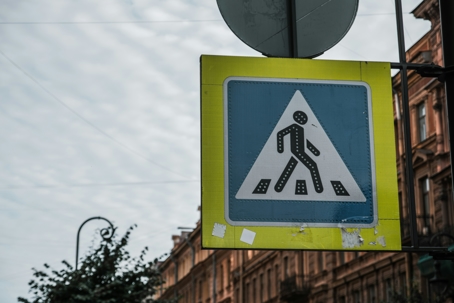When we think of pedestrian accidents, we often assume the driver is the one at fault. After all, vehicles are large, fast-moving, and potentially deadly machines. But in the legal world, especially here in Southern California, things aren’t always so clear-cut. In reality, a pedestrian can be held responsible for an accident, either partially or entirely.
This can come as a surprise to many people, but it's a crucial aspect of personal injury law that drivers and pedestrians alike need to understand. Whether you're walking across a street in Los Angeles or driving through a busy intersection in Glendale, knowing your rights and responsibilities is essential.
At Arshakyan Law Firm, we’ve successfully handled numerous pedestrian accident cases on both sides, helping injured pedestrians secure justice and defending drivers wrongfully blamed. As trusted Los Angeles attorneys, we’re here to break down how pedestrian fault works and what the jaywalking laws in California really mean.
Can a Pedestrian Be at Fault in a Car Accident?
Yes, pedestrians can absolutely be found at fault for a traffic accident. Just like drivers, pedestrians must follow the rules of the road. California law outlines specific duties for pedestrians, including using crosswalks, obeying traffic signals, and exercising caution when crossing streets.
If a pedestrian ignores these rules and causes an accident, they may be held legally liable for resulting injuries or property damage. The implications of being found at fault can include financial responsibility for damages, reduced or denied compensation for their own injuries, and legal liability in civil court.
Understanding California’s Jaywalking Law
Jaywalking refers to crossing a street outside of a designated crosswalk or against a pedestrian signal. Traditionally, this has been considered a violation of the law, and pedestrians could be cited or even fined for it.
In January 2023, California implemented the Freedom to Walk Act (AB 2147). This law changed how jaywalking is enforced. Under the new rules, police can only ticket a pedestrian for jaywalking if their crossing creates an immediate danger of a collision. This shift aims to reduce over-policing and promote equitable enforcement of pedestrian laws. However, it does not give pedestrians free rein to cross wherever they please. If a pedestrian crosses in front of a moving vehicle without giving the driver enough time to stop, and an accident occurs, they can still be held at fault.
Comparative Fault: How California Assigns Blame
California follows a pure comparative negligence system. This legal principle allows for the sharing of fault among multiple parties. Even if a pedestrian is partially to blame for the accident, they can still pursue compensation, but their percentage of fault will reduce their award.
For example, if you are injured in an accident and the court determines you were 30% at fault (perhaps you were jaywalking), and the total damages were $100,000, you would still be eligible to receive $70,000.
Situations Where Pedestrians May Be at Fault
1. Crossing Against the Signal
Pedestrians who enter a crosswalk during a 'Don't Walk' signal are violating traffic laws and may be found at fault if an accident occurs.
2. Jaywalking in Unsafe Conditions
Crossing mid-block during busy traffic or in poor visibility can be considered negligent, even under the new law.
3. Intoxicated Pedestrian Behavior
Being under the influence while walking can contribute to erratic behavior, increasing accident risk, and liability.
4. Walking While Distracted
Texting, using headphones, or being inattentive could lead a pedestrian into dangerous situations.
5. Children Darting Into Traffic
Drivers must exercise caution, but sudden and unpredictable behavior may reduce or share fault.
How Do Insurance Companies Handle Pedestrian Fault?
Insurance adjusters analyze statements, video footage, police reports, and physical evidence. They often attempt to shift blame onto pedestrians to reduce payouts. A seasoned attorney can ensure the process is fair and that the facts are clearly presented.
What Happens in Court? Real Examples of Shared Fault
Case 1: Jaywalking at Night
A pedestrian in Glendale was found 60% at fault for crossing unsafely at night but still received partial damages.
Case 2: Crosswalk Violation
A pedestrian began crossing during a red signal and was hit by a speeding vehicle. The court assigned equal fault.
Case 3: Pedestrian With Right-of-Way
A pedestrian hit during a lawful crossing was awarded full compensation after the driver was found 100% liable.
Pedestrian Safety Tips to Reduce Legal Risk
- Make eye contact with drivers
- Avoid distractions
- Use crosswalks
- Wear reflective clothing
- Wait for the signal
What Should Drivers Know About Pedestrian Liability?
Drivers are not always at fault. If a pedestrian acts unpredictably or illegally, the driver may not be held fully responsible. Consulting an experienced attorney can help establish a proper defense.
Legal Support for Injured Pedestrians and Drivers
Whether you're a pedestrian or a driver, Arshakyan Law Firm provides thorough investigation, negotiation with insurers, and powerful court representation. We serve clients throughout Los Angeles and Southern California and are committed to justice and results.
Pedestrian Accident Statistics in California
Understanding the scope of pedestrian accidents in California underscores the importance of knowing your rights and obligations. According to data from the California Office of Traffic Safety, over 1,000 pedestrians die and more than 14,000 are injured on California roadways each year. Los Angeles, with its dense traffic and high pedestrian activity, consistently ranks as one of the most dangerous cities for pedestrians in the United States.
Factors contributing to these high numbers include distracted driving, distracted walking, high-speed limits in urban areas, and limited pedestrian infrastructure in some neighborhoods. These statistics reveal the necessity for both drivers and pedestrians to exercise heightened awareness and responsibility.
Legal Definitions: Negligence and Duty of Care
In pedestrian accident cases, much of the legal discussion revolves around two key terms: negligence and duty of care. Negligence is defined as the failure to exercise reasonable care, resulting in damage or injury to another. In California, both pedestrians and drivers owe each other a duty of care.
For drivers, this includes yielding at crosswalks, obeying speed limits, and avoiding distractions. For pedestrians, the duty of care involves crossing at appropriate locations, obeying traffic signals, and remaining alert while walking. If either party breaches this duty and causes harm, they may be found negligent and therefore liable for damages.
When Pedestrians File Lawsuits: Legal Strategy and Expectations
If you're a pedestrian injured by a vehicle, you have the right to file a personal injury lawsuit against the at-fault driver. The success of your case depends on proving three things:
- The driver owed you a duty of care
- The driver breached that duty through negligent behavior
- That breach caused your injuries and damages
In situations where your own actions may have contributed to the accident, such as jaywalking or distraction, your lawyer will argue for a fair percentage of fault assignment. An experienced Los Angeles accident attorney will gather surveillance footage, interview witnesses, and consult medical and accident reconstruction experts to strengthen your claim.
When Drivers are Sued by Pedestrians
On the flip side, drivers facing pedestrian accident claims need to build a defense that demonstrates the pedestrian’s contribution to the incident. This may include showing that the pedestrian crossed illegally, appeared suddenly in traffic, or failed to exercise reasonable care.
Even in tragic circumstances, California’s comparative negligence rule allows for shared blame. This is often the deciding factor in settlements and verdicts. Having the right attorney ensures your side is properly represented, especially if the pedestrian is untruthful or if the situation was misrepresented in a police report.
Pedestrian Rights in Parking Lots and Private Property
Accidents don’t only occur on roads. Parking lots, sidewalks, and private driveways are also common locations for pedestrian injuries. In these cases, determining fault can become more complex. Was the area maintained properly? Were the signs visible? Did the driver have a clear view?
Property owners may also share liability if unsafe conditions contributed to the accident. Arshakyan Law Firm routinely investigates premises liability when evaluating pedestrian injury claims, ensuring that all responsible parties are held accountable.
What Damages Can Pedestrian Accident Victims Recover?
If you’ve been injured in a pedestrian accident, you may be entitled to recover damages for:
- Medical bills and rehabilitation costs
- Lost wages and future income
- Pain and suffering
- Emotional distress
- Loss of quality of life
- Property damage (e.g., phone, glasses, personal belongings)
In wrongful death cases, families may also seek funeral expenses, loss of companionship, and other damages under California’s survivor statute. An experienced Southern California attorney ensures your compensation reflects the full extent of your losses.
Conclusion: Can a Pedestrian Be at Fault in an Accident?
Yes, pedestrians can be at fault. From jaywalking to distracted walking, their actions impact legal responsibility. California’s comparative fault laws allow for shared liability and compensation depending on the situation.
The most critical step? Get legal help. Whether you're seeking justice or defending yourself, trust Arshakyan Law Firm.
We offer free consultations. Call us today at (818) 650-9985 to speak with one of our experienced Southern California personal injury lawyers. We are in your corner!

